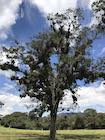Prumnopitys montana
(Humb. & Bonpl.) de Laub. 1978
Common names
Chaquiro, diablo fuerte [Spanish] (Miller and Quinn 2001), pino negro, pino hayuelo (Nicolás Baresch Uribe, 2023.03.08).
Taxonomic notes
Syn. (Farjon 1998):
- Taxus montana Humb. et Bonpl. ex Willd. 1806;
- Podocarpus montanus (Humb. et Bonpl. ex Willd.) Lodd. ex Britton 1889;
- Nageia montana (Humb. et Bonpl. ex Willd.) Kuntze 1891;
- Podocarpus taxifolius Kunth in Humboldt et al. 1817;
- Podocarpus taxifolius Kunth var. communis Kunth in Humboldt et al. 1817;
- Dacrydium distichum D. Don in Lambert 1828;
- Stachycarpus taxifolius (Kunth) Tiegh. 1891;
- Podocarpus taxifolius Kunth var. densifolius Kunth in Humboldt et al. 1817;
- Podocarpus montanus (Humb. et Bonpl. ex Willd.) Lodd. var. diversifolius Dallim. et A.B. Jacks. 1923;
- Podocarpus montanus (Humb. et Bonpl. ex Willd.) Lodd. var. densifolius J. Buchholz et N.E. Gray 1948;
- Podocarpus montanus (Humb. et Bonpl. ex Willd.) Lodd. var meridensis J. Buchholz et N.E. Gray 1948.
Description
Trees to 30 m tall and 150 cm dbh, typically with single straight bole, buttressed, and spreading branches forming a rounded crown. Bark first smooth, later scaly and peeling away in small strips, purplish brown weathering to gray. Leaves alternate, pectinate, twisted at a petiolate base, linear, slightly curved above base, widest above the middle, 12-20 × 2.0-3.5 mm (only 1.8-2.3 mm wide on seedlings and saplings), with an adaxial (upper) grooved midrib and an abaxial (lower) midrib; margins entire; apex mostly acuminate; flushing yellow-green, maturing dark lustrous green above and glaucous green below, with stomata in numerous lines on lower side. Pollen cones in lateral and axillary spikes near the ends of branches, up to 25 spreading cones per spike, each 5-10 × 2 mm. Seed cones solitary or paired on 2-3 cm long twigs, consisting of an epimatium that ripens yellow, 14-16 × 10-12 mm, entirely covering an ovoid, slightly flattened seed (Farjon 2010).
Distribution and Ecology
Colombia, Ecuador, Peru and Venezuela, in the Andean regions, at elevations of 1500-3600 m. This is high montane tropical cloud forest dominated by angiosperms, including Bejaria, Citharexylum, Clusia, Juglans, Octoea, Oreopanax and Weinmannia; at the highest elevations the forest changes to elfinwood or scrub, often dominated by Ericaceae or Podocarpaceae, where Prumnopitys is a short but emergent tree. Epiphytes are abundant, and on some sites soils are so wet that Sphagnum dominates the ground cover (Farjon 2010, Gardner 2013).
Zone 10 (cold hardiness limit between -1°C and +4.4°C) (Bannister and Neuner 2001).
The IUCN classifies this species as "Vulnerable" to human impacts due to intensive logging since the 1950s that has eliminated or considerably reduced many formerly extensive stands, particularly in Colombia and Peru. This has greatly fragmented the habitat and contributed to isolation of populations. There has also been substantial habitat loss due to deforestation associated with agroforestry. The timber of Podocarpaceae in tropical South America has great value and all remaining trees are at risk, even those in protected areas; furthermore, there is no reason to believe the situation will improve significantly in the future, even though many important stands are protected within national parks (Gardner 2013).
Remarkable Specimens
No data as of 2023.02.28.
Ethnobotany
Currently this is still an economically important species; the wood is valued for uses including construction, tool handles, general carpentry, floors and cabinetmaking. Its yellow sapwood and reddish heartwood make it attractive for turning. In deforested areas, small trees are often left standing to provide shade for cattle. The species is rare in cultivation, though (Farjon 2010, Gardner 2013).
Observations
GBIF (accessed 2023.02.28) inventories 180 georeferenced observations, and Gardner (2013) notes that the species is present in a variety of protected areas, such as Parque Regional Ucumarí, Parque Nacional Los Nevados, Parque Nacional Puracé, and Parque Nacional Nevado del Huila in Colombia.
Remarks
The epithet means "of the mountains", referring to its habitat.
Citations
Gardner, M. 2013. Prumnopitys montana. The IUCN Red List of Threatened Species 2013: e.T42540A2986067. https://dx.doi.org/10.2305/IUCN.UK.2013-1.RLTS.T42540A2986067.en, accessed 2023.02.28.
Laubenfels, David J. d. 1978. The genus Prumnopitys (Podocarpaceae) in Malesia. Blumea 24:189-190.
Mill, R.R. and C.J. Quinn. 2001. Prumnopitys andina reinstated as the correct name for "lleuque", the Chilean conifer recently renamed P. spicata (Podocarpaceae). Taxon 50(4):1143-1154.
See also
Nieto, V. M. and J. Rodriguez. 2003. Podocarpus montanus. Species description in the Tropical Tree Seed Manual. Available http://www.rngr.net/Publications/ttsm/Folder.2003-07-11.4726 (accessed 2007.08.31).
The species account at Threatened Conifers of the World.



